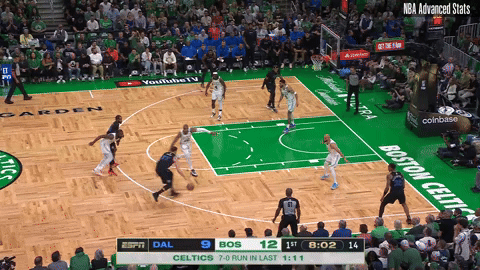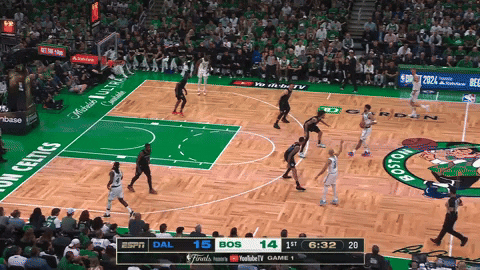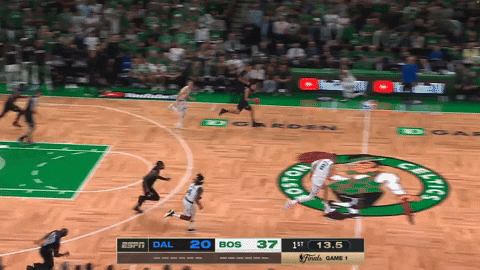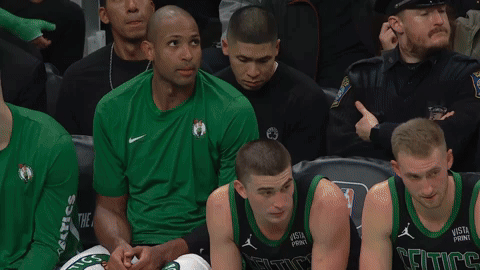3 x 3 x 3 The Preview
Completing our 3 x 3 x 3
Jason Kidd is already trying to play mind games. His comments about Jaylen Brown being the Boston Celtics' best player were clearly intended to shift focus onto the Celtics and create a potentially divisive narrative.
Kendrick Perkins said it best in a post on X: “J-Kidd might think that Jaylen Brown is the best player on the Celtics, but he’s doing exactly what you’re supposed to do in the NBA Finals… and that’s try to pull out every trick in the book to try and distract the Celtics!!!! It’s Fair Game when trying to win a Championship.”
I get what Kidd is trying to do here. I think we all do. However, for me, Kidd played this hand far too early. Is he so unsure of his team’s ability to adjust and counter the Celtics’ offensive and defensive system that he has to resort to gamesmanship after one game? Is he that scared of how Tatum and Brown dismantled his team’s defense?
This feels like a move you play heading into a Game 3 or Game 4. Playing at home. In front of your own fans. Ramping up the pressure from every angle.
Not after one loss.
Not when you’re playing a second game in the TD Garden.
The Celtics are used to these narratives. Tatum and Brown have been compared to each other throughout their careers. Questions regarding their relationship have been rife, as have the questions about their ability to play together and lead the team to a championship.
Well, I hate to break it to ya, but they’re three wins away from dispelling all of those questions.
Maybe Kidd didn’t get the memo.
Let Kidd do Kidd, though.
Control what you can control. That’s exactly what the Celtics need to do. The Dallas Mavericks will undoubtedly play better in this series; that much is inevitable. Yet, the Celtics have got a few more gears they can cycle through when needed. Both teams have areas they can improve.
Make no mistake, though: After getting scrambled by the Celtics' relentlessness, the Mavericks are left with egg on their face. There's no whisking away the reality: their overall blueprint is toast. They must poach new strategies, or this series will be over easy.
Let's look at some of the nuances that helped the Celtics jump out to an early series lead.
Tatum’s defensive role
The what: Joe Mazzulla had Jayson Tatum match up with the Mavericks' frontcourt, splitting time between the 5s and the 4s.
"There's a lot of guys that are my height, but they're better defenders on the perimeter,” Tatum told Brian Scalabrine during an interview with NBC Sports Boston. “But when they get to the post, when guys are stronger, then they have a tougher job. So, I don't want to be one of those guys that you have to hide. I pride myself on being one of the best players and that means on both ends of the floor."
The why: Outside of Derreck Lively II, Tatum is as tall as everyone in the Mavericks front court. He can match their physicality in the post. He’s versatile enough to guard down on the perimeter. His size and timing make him one of the most reliable help defenders around the rim in the NBA.
So, putting Tatum on opposing bigs works for two reasons.
It allows him to switch when defending the pick-and-roll. With Tatum’s size and length, he can be a tough opponent when looking to penetrate and get to the rim. He’s strong enough to absorb contact and has the wingspan to contest shots on the move.
He can operate as a roamer — the same role we saw Rob Williams play during the 21-22 season. Rotating over as a help defender, boxing out or challenging guys at the rim.
An underappreciated stat from Game 1 is that Tatum led the game in box outs.
Mazzulla is trusting Tatum to make the right defensive decision in every possession. He’s giving Tatum freedom to make reads, whether that’s a switch, a close-out, staying home, boxing out or rotating toward the rim.
Tatum’s role is a tough puzzle for the Mavericks to figure out. Lively and Gafford are the primary screeners in the 1/2-5 PnR with Doncic or Kyrie Irving. Getting Tatum switched onto you is far from ideal. The same argument applies when drawing Horford out of the paint and attacking the rim; you’re being met by a 6’10’’ forward with underappreciated athleticism and bounce. He’s going to impact shots, and he’s going to alter dunk attempts.
The how: Kidd could lean into the Doncic/Irving matchups with Tatum to test how well he does when consistently being forced to guard on the move. Having Gafford or Lively cut from the corners, baseline or elbows to set step-up screens would force the switch and put Tatum directly in the action.
I don’t think this is a wise strategy. Tatum is one of the best on-ball defenders at his position.
However, if Mazzulla wanted to keep Tatum fresh and avoid putting even more onto his shoulders, he could instruct his team to peel switch or pre-switch PnRs that put Tatum in the action. That way, Tatum can return to his original matchup and continue limiting Dallas’ ability to generate rim threats on lobs or secondary cuts. Boston has options.
I’m still chasing the 1,000 subscriber mark before the end of the season. We’re getting close. The community is growing every day. If you’re new here, hit the subscribe button and help me keep growing this newsletter!
Winning the corner battle
The what: We’ve touched on this aspect multiple times already, but for me, it’s one of the biggest swing factors in the series. Whichever team can consistently control the corners will have the biggest chance of success in this series.
“The gravity and creation of Irving and Doncic creates open shooting opportunities elsewhere on the court. There’s a reason why they ranked 1st in corner threes throughout the regular season. Jason Kidd has them playing a spray offense while making reads out of doubles.”
This is what I wrote when working on the scouting report before the series began. The Celtics don’t base their offense around hitting corner jumpers. Only 9.9% of their offense comes from that part of the floor. However, they did finish the regular season as the best corner three teams in the NBA, converting at 43.6%.
The why & how: Dallas’ defense is designed around funneling the ball toward the corners. I dove into how and why the Mavericks do this in the 3 x 3 x 3 defensive piece earlier this week.
3 x 3 x 3: Defense edition
The Celtics are more than capable of making reads to open shooters in the corners and nailing those looks, regardless of whether a late shot contest is coming from elsewhere on the floor.
Having playmakers like Tatum on the floor will help the Celtics find consistent scoring opportunities when the defense collapses. This play was one of my favorites from him during the game. He finds himself switched onto Lively with the Celtics spaced in a 5-out. Tatum waves off the screen from Porzingis and takes the rookie big man off the dribble.
As Tatum penetrates and the defense sinks into the paint, he surprises everyone. The pass to Brown in the strongside corner is the most logical. He’s one pass away. He’s an elite catch-and-shoot threat. However, White has more room on the weak corner, so Tatum hits a contorted jump pass to find White on the opposite side of the floor.
You won’t see passes like that all the time. Yet it does work as a solid illustration of how the Celtics can look to generate looks in the corner as the defense reacts to a drive. From there, Boston can shoot it, drive baseline, or enter into a side PnR and look to create out of a secondary action.
Dallas will bait the Celtics into taking shots out of the corners. If it makes sense, Boston will happily let it fly. However, the bonus of having multiple guys who can put the ball on the floor is that they’re not pressured into becoming a catch-and-shoot offense. Secondary and tertiary actions won’t scare Mazzulla’s team. They will embrace what’s given to them.
On defense, the Celtics are the antithesis of what the Mavericks are looking for. They rarely send two to the ball. They scarcely overload, and their help defense is usually well-timed and designed to minimize the risk of being cooked on kick-outs.
Leaning into Porzingis
The what & why: Kristaps Porzingis came off the Celtics bench in Game 1. He will likely come off the bench in Game 2, as the Celtics take a cautious approach with him following his return from injury. However, he was undoubtedly the catalyst for Boston jumping out to an early lead.
His size and shooting were the coup de grace. Dallas couldn’t figure him out. He cooked them around the nail if they looked to run him off the three-point line. If they drew him out of the paint on defense, he moved his feet and contested shots on the move.
Dallas’ defense struggled with the spacing of the Celtics. They were punished every time they looked to overload the strong side, send two at the ball, or adjust their pick-up points higher up the court. Porzingis was a huge part of that. He’s the tallest player in this series. He can see over the defense and make consistent reads when he’s forced to lean into his playmaking.
Boston must be careful, though. The Mavericks will look to ramp up the physicality when guarding Porzingis to try and take him out of his comfort zone. Finding ways to put him in a winning position and create enough space for him to make an impact will be the biggest part of the coaching chess match.
The how: The beauty of Porzingis’ skillset is his versatility. The Celtics can lean into different aspects of his skillset to counter how the Mavericks look to defend him. For example, if Kidd instructs his team to get physical when Porzinigs is posting up, the Celtics could look to use him as a cutter, allowing him to get deeper into the paint.
Porzingis can cut off rip screens or position himself in the corner and work as a baseline threat on secondary cuts that mirror a drive or work as a release valve. Positioning him away from the action and then having him attack space off-ball would limit the amount of physicality and pressure Dallas could send his way. There are four other elite scoring threats the Mavericks need to be cognizant off, which could allow Porzingis to cook in a non-ball-dominant role.
Boston could also run Porzingis off of flare screens to get him easy catch-and-shoot looks. Or ask him to be the popper in pick-and-pop scenarios.
Mazzulla has a multitude of options at his disposal. Porzingis’ positional versatility and unique skill set for his size make him a valuable weapon when looking to counter Dallas’ defensive and offensive systems.
He will have a big role to play in this series. He will undoubtedly want to keep building on the performance we saw from him in Game 1. It will be interesting to see what wrinkles Mazzulla adds to the offensive game plan to keep Porzingis involved while adjusting for how the defense looks to counter his impact.
The plan for tomorrow
My plan for tomorrow is to look at the inverted dunker spot actions we’ve seen from the Celtics. I’m assuming there will be a couple in tonight’s game, and there were a few in Game 1. Of course, the result of Game 2 will dictate whether that plan changes, but for now, that’s my hope.
Until then, I hope everyone enjoys tonight and stays safe! Catch y’all later!
Word of mouth is the best way for this newsletter to grow. If you enjoyed this post, please share with your friends, family, social media network or anywhere else you can think of!






